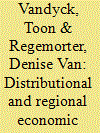|
|
|
Sort Order |
|
|
|
Items / Page
|
|
|
|
|
|
|
| Srl | Item |
| 1 |
ID:
149130


|
|
|
|
|
| Summary/Abstract |
Financial regulatory networks are a pervasive new type of global governance heralded by some as a flexible answer to globalization dilemmas and dismissed by others as ineffective because of weak enforcement mechanisms. Whether regulatory network agreements provide global public goods or private goods for certain states’ firms is a second debated issue. This article adjudicates among competing perspectives by examining whether Basel III, an international agreement about bank capital minimums negotiated by the bank regulatory network in 2009 and 2010, was viewed as credible and affecting regulated US firms. I use stock returns to measure investors’ perceptions, and an event study methodology to test whether regulated banks’ observed stock returns significantly differ from expected stock returns on days when new information about Basel III becomes available. If the agreement is viewed as credible and affecting firm value, banks’ stock returns will deviate from expectations. The direction of any deviation indicates whether regulations benefit or hurt banks. Although the direction of effects is not uniform across events, I find that the initial stock return reaction and the net effect across all five events are negative, and of a similar magnitude as regulated foreign banks, indicating that US banks were harmed, and did not benefit from, the new international regulations. US banks experienced stock returns that differed from expectations, providing evidence that international regulatory network agreements are viewed as credible and tangibly affect firms independent of domestic implementation.
|
|
|
|
|
|
|
|
|
|
|
|
|
|
|
|
| 2 |
ID:
132611


|
|
|
|
|
| Publication |
2014.
|
| Summary/Abstract |
We analyse the macroeconomic and distributional effects of increased oil excises in Belgium by combining a regional Computable General Equilibrium (CGE) model with a microsimulation framework that exploits the rich detail of household-level data. The link between the CGE model and the microlevel is top-down, feeding changes in commodity prices, factor returns and employment by sector into a microsimulation model. The results suggest that policymakers face an equity-efficiency trade-off driven by the choice of revenue recycling options. When the additional revenue is used to raise welfare transfers to households, the reform is beneficial for lower income groups, but output levels decrease in all regions. However, when the energy tax revenue is used to lower distortionary labour taxes, the tax shift is slightly regressive. In this case, national GDP is hardly affected but regional production levels diverge. The impact of the environmental tax reform on income distribution depends strongly on changes in factor prices and welfare payments, whereas sector composition is an important determinant for regional impact variation.
|
|
|
|
|
|
|
|
|
|
|
|
|
|
|
|
| 3 |
ID:
132621


|
|
|
|
|
| Publication |
2014.
|
| Summary/Abstract |
The Australian Renewable Energy Target (RET) has spurred significant investment in renewable electricity generation, notably wind power, over the past decade. This paper considers distributional implications of the RET for different energy users. Using time-series regression, we show that the increasing amount of wind energy has placed considerable downward pressure on wholesale electricity prices through the so-called merit order effect. On the other hand, RET costs are passed on to consumers in the form of retail electricity price premiums. Our findings highlight likely significant redistributive transfers between different energy user classes under current RET arrangements. In particular, some energy-intensive industries are benefiting from lower wholesale electricity prices whilst being largely exempted from contributing to the costs of the scheme. By contrast, many households are paying significant RET pass through costs whilst not necessarily benefiting from lower wholesale prices. A more equitable distribution of RET costs and benefits could be achieved by reviewing the scope and extent of industry exemptions and ensuring that methodologies to estimate wholesale price components in regulated electricity tariffs reflect more closely actual market conditions. More generally, these findings support the growing international appreciation that policy makers need to integrate distributional assessments into policy design and implementation.
|
|
|
|
|
|
|
|
|
|
|
|
|
|
|
|
| 4 |
ID:
179700


|
|
|
|
|
| Summary/Abstract |
The introduction of Time of Use (ToU) tariffs may affect residential electricity consumers differently depending not only on their financial position but also time availability. The aim of this paper is to identify socio-demographic groups which may be financially advantaged or disadvantaged by the introduction of ToU tariffs. Assuming no behavioural change, we impose ToU tariffs on UK half hourly smart meter data and the synthetic demand profiles for different household composition generated using the 2014–2015 UK Time Use Survey data and optimisation of energy consumption per activity against the smart meter data. The distributional effects of ToU tariffs are obtained for customer segmentation and socio-demographic groups, and presented in terms of peak to off-peak ratios and impacts on the synthetic demand profiles. Findings on the distributional effects of ToU tariffs reveal regional differences (e.g. positive effects for high income groups in London) and household composition similarities (e.g. positive effects for households with children not in the high-income group).
|
|
|
|
|
|
|
|
|
|
|
|
|
|
|
|
| 5 |
ID:
150374


|
|
|
|
|
| Summary/Abstract |
Distributional incidences are fundamental to environmental and energy policies, a condition that has led to controversies on the equity of environmental and energy policy. Using data from China's Urban Household Income and Expenditure Survey data from 2007, this study quantified the distributional effects of the green electricity price subsidy policy among Chinese urban household and compared its effects by using lifetime income and annual income to classify households, respectively. The results show that total electricity subsidies are mainly driven by indirect electricity subsidies. By using lifetime income to classify households, subsidies to households in the poorest two groups accounted for less than 10.2% of the total subsidies, whereas money distributed to households in the top two deciles reached 35.4%. The comparison using annual income to group households also demonstrated the similar impact of the green electricity price subsidy policy. China’s future market reforms should allow electricity prices to reflect pollution abatement costs. Additionally, a multi-step block electricity price schedule can reduce the regressivity of the policy.
|
|
|
|
|
|
|
|
|
|
|
|
|
|
|
|
| 6 |
ID:
150396


|
|
|
|
|
| Summary/Abstract |
In Italy, the cost of support for renewable electricity (RES-E) is largely recovered through the “A3 surcharge”, which weighs heavily on electricity bills. Using household survey data, we show the A3 surcharge is markedly regressive. Carbon taxation in the non-ETS sector is envisaged as a means to reduce CO2 emissions cost-effectively and generate revenue to lower the A3 surcharge. A non-ETS carbon tax would be less regressive than the A3 surcharge and its cost would be more evenly distributed across households. We calculate the revenue of a €20/tCO2 non-ETS carbon tax would have allowed a cut in the A3 surcharge of about 68% in 2011, and 39% in 2012. The impact of the carbon tax plus the reduced A3 surcharge would have been less regressive, but the cost higher for most households. The restrictions imposed in the simulations mean the results are only appropriate to render first-round effects of the reform.
|
|
|
|
|
|
|
|
|
|
|
|
|
|
|
|
| 7 |
ID:
190610


|
|
|
|
|
| Summary/Abstract |
Despite the consensus that green taxation is an effective way to accelerate the decarbonization of economies, few countries are implementing ambitious tax reforms. This is the case of diesel for transport in Spain. The arguments against boosting the diesel tax stressed its potential adverse effects on the economy and society, accusing it of being a regressive policy. In this paper, we shed light on the distributional impact of raising the excise tax on diesel to the same level as on gasoline for final consumers in Spain and various compensation schemes jointly designed with several stakeholders. The results confirm that raising the diesel tax without offsets would have slightly regressive effects and that rural and middle-income households would bear the brunt of the increase. However, the effects become progressive when the co-designed offsetting schemes are implemented. These findings may help decision-makers in achieving a just, acceptable, and politically viable energy transition.
|
|
|
|
|
|
|
|
|
|
|
|
|
|
|
|
| 8 |
ID:
177497


|
|
|
|
|
| Summary/Abstract |
A German panel data of vehicle and owner characteristics is used to analyse the incidence of additional carbon taxes. It is shown that an additional carbon tax on fuel used for private transportation is regressive when there is no allocation of tax revenue. When smoothing consumption across time in the face of additional carbon taxes, low income households can reduce the tax burden. When the cost of air pollution is included in the metric for the tax incidence, the tax burden decreases considerably. It is also found that in order to charge drivers for the attributed emissions, carbon taxes need to be set at least at €30 per tonne of CO2 emissions. Moreover, the estimated own price elasticities suggest that an additional carbon tax may fail to induce owners of vehicles with an intense usage to reduce energy consumption. Consequently, carbon taxes need to be designed jointly with other taxes to target heavy polluters.
|
|
|
|
|
|
|
|
|
|
|
|
|
|
|
|
| 9 |
ID:
183057


|
|
|
|
|
| Summary/Abstract |
We quantify the vertical (i.e. between income differences) and horizontal (i.e. within income differences) distributional effects of carbon taxation using a fully flexible demand system and Irish data. The model avoids imposing the curvature of the relationship between income and energy demand. We show that neglecting this fact can lead to misleading policy conclusions. We also show that losses in purchase power are the main channel of welfare losses. Losses due to limitations for energy substitution play a minor role. We found that rural households and householders in retirement age are the most affected by carbon taxation. Regarding horizontal effects, we show that higher heterogeneity in the tax burden is experienced by couples with dependent children and those in urban households. These findings highlight the importance of quantifying both horizontal and vertical distributional effects when designing carbon taxes and revenue recycling mechanisms. Within distributional effects are larger than between distributional effects regarding income inequality of the tax and revenue recycling mechanisms. We found that a targeted transfer is preferred over a lump-sum transfer in reducing welfare losses caused by the regressivity of taxation. These findings hold when measuring both horizontal and vertical distributional effects.
|
|
|
|
|
|
|
|
|
|
|
|
|
|
|
|
|
|
|
|
|